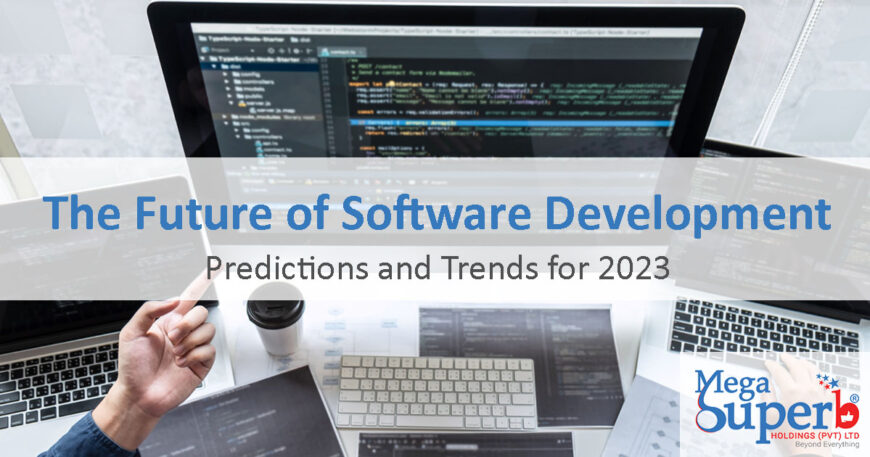Software development has come a long way since the first computer programs were written in the 1940s. Today, software is an integral part of virtually every industry, from healthcare and finance to entertainment and transportation. As technology continues to evolve, so too does the way we develop software. In this article, we’ll explore some of the predictions and trends that are shaping the future of software development.
Predictions for the Future of Software Development
As we look towards the future of software development, there are a number of exciting trends and predictions on the horizon. Here are some of the most significant:

a. Artificial Intelligence and Machine Learning
Artificial intelligence (AI) and machine learning (ML) are poised to revolutionize the way we approach software development. With the ability to analyze vast amounts of data and learn from it, these technologies are already being used to automate routine development tasks and improve the accuracy of testing and debugging. In the coming years, we can expect AI and ML to play an increasingly important role in the development process, from automating more complex tasks to enabling more sophisticated applications.
b. Low-code/No-code Development
Another trend that is rapidly gaining traction is low-code/no-code development. This approach allows developers to build applications using visual interfaces and drag-and-drop components, rather than writing code from scratch. The result is faster development times and increased flexibility, as well as the ability for non-technical stakeholders to contribute to the development process. As these tools become more sophisticated and widely adopted, we can expect them to become a core part of the software development toolkit.
c. Cloud-Native Applications
Cloud-native applications are designed to take full advantage of the capabilities of cloud computing, with a focus on scalability, resilience, and automation. As more organizations move their applications to the cloud, we can expect cloud-native development practices to become increasingly important. This includes the use of containerization and orchestration tools like Kubernetes, as well as the adoption of serverless architectures and event-driven programming models.
d. Internet of Things (IoT)
The Internet of Things (IoT) refers to the network of interconnected devices and sensors that are becoming increasingly common in our homes, workplaces, and cities. As the number of IoT devices continues to grow, software developers will need to adapt to the unique challenges posed by this environment. This includes developing applications that can handle large amounts of data, as well as ensuring that security and privacy are a top priority.
e. Quantum Computing
Finally, quantum computing is another emerging trend that is likely to have a significant impact on the future of software development. While still in its early stages, quantum computing has the potential to solve complex problems that are beyond the capabilities of classical computers. This could lead to new applications in areas like cryptography and machine learning, as well as the development of new algorithms and programming languages.
The Rise of Low-Code/No-Code Development
One of the most significant trends in software development in recent years has been the rise of low-code/no-code development platforms. These platforms allow developers and non-technical users alike to build applications using visual interfaces and pre-built components, without having to write large amounts of code by hand.
a. What is Low-Code/No-Code Development?
Low-code/no-code development refers to the use of visual interfaces and pre-built components to create applications without requiring extensive hand-coding. These platforms typically include drag-and-drop interfaces, visual workflows, and pre-built integrations with common enterprise systems like CRM and ERP.
b. Benefits of Low-Code/No-Code Development
Low-code/no-code development platforms offer a number of benefits to software developers and companies. For developers, these platforms can help accelerate the development process, reduce the need for manual coding, and increase collaboration between developers and non-technical stakeholders. For companies, low-code/no-code development can help accelerate time-to-market for new applications, reduce costs, and improve overall productivity.
c. Challenges with Low-Code/No-Code Development
While low-code/no-code development platforms offer many benefits, they also present some challenges. One of the biggest challenges is the potential for the proliferation of shadow IT, where non-technical users may build applications that do not meet the same standards for security and compliance as those built by professional developers. Additionally, these platforms may not always offer the same level of customization and flexibility as traditional hand-coding, which could limit their usefulness in certain situations.
d. Future of Low-Code/No-Code Development
Despite these challenges, the future of low-code/no-code development looks bright. As these platforms continue to evolve and mature, they are likely to become more widely adopted and more capable of supporting enterprise-grade applications. This could lead to a future where non-technical users are able to build sophisticated applications with ease, while developers focus on more complex and specialized projects.
Implications for Software Developers and Companies
As the future of software development continues to take shape, there are a number of important implications for software developers and companies. Here are some of the most significant:
a. The Need for Upskilling and Staying Current with New Technologies
In order to stay competitive in an ever-evolving industry, software developers will need to continuously upskill and stay current with new technologies. This includes not only learning new programming languages and tools, but also staying informed about emerging trends like AI, machine learning, and cloud-native development. Similarly, companies will need to invest in ongoing training and development for their employees in order to remain competitive in the marketplace.
b. The Potential for Increased Efficiency and Productivity
As software development tools and technologies continue to improve, there is the potential for increased efficiency and productivity in the development process. For example, low-code/no-code development tools can help developers build applications faster and with less manual coding. Similarly, the use of agile development methodologies and DevOps practices can help teams collaborate more effectively and deliver software more quickly.
c. The Importance of Security and Data Privacy
As software becomes more central to our lives, the importance of security and data privacy will only continue to grow. Software developers and companies will need to take proactive steps to ensure that their applications are secure and that user data is protected. This includes implementing best practices like encryption, regular security testing, and strict access controls.
d. The Need for Collaboration and Teamwork
Finally, as software development becomes more complex and specialized, the need for collaboration and teamwork will become increasingly important. Developers will need to work closely with other members of their team, including designers, product managers, and quality assurance professionals, in order to build high-quality software that meets the needs of end users. Companies will also need to create a culture of collaboration and teamwork in order to foster innovation and drive success.
In conclusion, the future of software development is full of exciting possibilities, but it also presents a number of challenges for developers and companies alike. By staying current with emerging trends and investing in ongoing training and development, software professionals can help ensure that they are well-prepared to navigate this rapidly evolving landscape.
Conclusion The Future of Software Development
In conclusion, software development is a constantly evolving field, with new technologies and trends emerging all the time. In this article, we’ve explored some of the most important predictions and trends for software development in 2023 and beyond, including the rise of AI and machine learning, the shift towards cloud-native development, the increased emphasis on low-code/no-code development, and the importance of software security.
As these trends continue to shape the software development landscape, it’s important for developers and companies to embrace the future of software development and stay up-to-date with the latest tools and technologies. By doing so, they can stay ahead of the curve and deliver innovative and secure applications that meet the needs of their customers and stakeholders.
In light of these trends, we encourage software developers and companies to explore new development approaches, invest in training and upskilling, and embrace emerging technologies to stay competitive in the rapidly changing software development industry. With the right mindset and tools, the future of software development is full of exciting possibilities.




